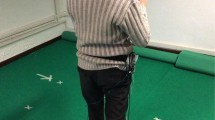Abstract
When a human crinkles or scrunches a fragile object, for which the yield force is very small that it is hardly perceived, they identify the material of the object based on tactile stimuli delivered to the skin. In addition, humans are able to recognize materials even when they are crinkled at different speeds. In order to realize these human recognition features of the crinkle of a fragile object, we develop a vibrotactile synthesis method. This method synthesizes the vibrotactile acceleration stimuli in response to a crinkle speed based on the preliminarily measured acceleration spectra. Using this method, we develop an active footstep display that presents a virtual crinkle of fragile structures made of different materials to its users. Experimental participants could identify three of the four types of virtual structure materials at rates significantly higher than the chance level. The four materials were copy and typing paper, aluminum foil, and polypropylene film. Furthermore, the trends of answer ratios exhibit good correspondence with those for the real cylindrical fragile objects. We conclude that the developed method is valid for the virtual crinkle of fragile structures and will enhance the validity of virtual reality systems, such as a virtual walkthrough system.













Similar content being viewed by others
References
Agus M, Giachetti A, Gobbetti E, Zanetti G, Zorcolo A (2003) Real-time haptic and visual simulation of bone dissection. Presence 12(1):110–122
Arbabtafti M, Moghaddam M, Nahvi A, Mahvash M, Richardson B, Shirinzadeh B (2011) Physics-based haptic simulation of bone machining. IEEE Trans Haptics 4(1):39–50
Bensmaïa SJ, Hollins M (2000) Complex tactile waveform discrimination. J Acoust Soc Am 108:1236–1245
Bensmaia S, Hollins M (2005) Pacinian representations of fine surface texture. Percept Psychophys 67(5):842–854
Bensmaia S, Hollins M, Yau J (2005) Vibrotactile intensity and frequency information in the pacinian system: a psychophysical model. Percept Psychophys 67(5):828–841
Chim J, Lau RWH, Leong HV, Si A (2003) Cyberwalk: a web-based distributed virtual walkthrough environment. IEEE Trans Multimed 5(4):503–515
Cholewiak SA, Kim K, Tan HZ, Adelstein BD (2010) A frequency-domain analysis of haptic gratings. IEEE Trans Haptics 3(1):3–14
Fujino S, Sato D, Abe K, Konno A, Uchiyama M (2008) Displaying feeling of cutting by a micro-scissors type haptic device. In: Proceedings the 2008 IEEE international conference on robotics and automation, pp 2067–2072
Israr A, Tan HZ (2006) Frequency and amplitude discrimination along the kinesthetic-cutaneous continuum in the presence of masking stimuli. J Acoust Soc Am 120(5):2789–2800
Kavounoudias A, Roll R, Roll JP (1999) Specific whole-body shifts induced by frequency-modulated vibrations of human plantar soles. Neuroscience 266:181–184
Law AW, Peck BV, Visell Y, Kry PG, Cooperstock JR (2008) A multi-modal floor-space for experiencing material deformation underfoot in virtual reality. In: Proceedings of the IEEE international workshop on haptic audio visual environments and games, pp 126–131
Lurie KL, Shull PB, Nesbitt KF, Cutkosky MR (2011) Informing haptic feedback design for gait retraining. In: Proceedings the 2011 IEEE World haptics conference, pp 19–24
Maki BE, Perry SD, Norrie RG, McIlroy WE (1999) Effect of facilitation of sensation from plantar foot-surface boundaries on postural stabilization in young and older adults. J Gerontol Ser A 54(6):M281–M287
Morioka M, Griffin MJ (2005) Perception thresholds for vertical vibration at the hand, seat and foot. In: Proceedings of the European Acoustic Association forum Acusticum 2005, pp 1577–1582
Okamoto S, Yamada Y (2011) An objective index that substitutes for subjective quality of vibrotactile material-like textures. In: Proceedings of the 2011 IEEE/RSJ international conference on intelligent robots and systems, pp 3060–3067
Okamoto S, Ishikawa S, Nagano H, Yamada Y (2011) Spectrum-based vibrotactile footstep display for crinkle of fragile structures. In: Proceedings of the 2011 IEEE international conference on robotics and biomimetics pp 2459–2464
Okamura AM, Webster III RJ, Nolin JT, Johnson KW, Jafry H (2003) The haptic scissors: cutting in virtual environments. In: Proceedings of the 2003 IEEE international conference on robotics and automation, pp 828–833
Park G, Choi S (2011) Perceptual space of amplitude-modulated vibrotactile stimuli. In: Proceedings of the 2011 IEEE World haptics conference, pp 59–64
Rafferty MM, Aliaga DG, Popescu V, Lastra AA (1998) Images for accelerating architectural walkthroughs. IEEE Comput Graph Appl 18(6):38–45
Roll R, Kavounoudias A, Roll JP (2002) Cutaneous afferents from human plantar sole contribute to body posture awareness. Neuroreport 13(15):1957–1961
Velázquez R, Bazán O, Magaña M (2009) A shoe-integrated tactile display for directional navigation. In: Proceedings the 2009 IEEE/RSJ international conference on robots and inteligent systems, pp 1235–1240
Visell Y, Cooperstock JR, Giordano BL, Franinovic K, Law A, McAdams S, Jathal K, Fontana F (2008) A vibrotactile device for display of virtual ground materials in walking. In: Proceedings of EuroHaptics 2008, pp 420–426
Visell Y, Law A, Cooperstock JR (2009) Touch is everywhere: floor surfaces as ambient haptic interfaces. IEEE Trans Haptics 2(3):148–159
Wakamatsu H, Zhang X, Honma S (1998) Teleoperational force display system in manipulation of virtual object using scissors-type cutting device. In: Proceedings of the 3rd Asia-Pacific conference on control & measurement, pp 312–316
Wang D, Zhang Y, Wang Y, Lee Y, Lu P, Wang Y (2005) Cutting on triangle mesh: local model-based haptic display for dental preparation surgery simulation. IEEE Trans Vis Comput Graph 11(6):671–683
Watanabe J, Ando H, Maeda T (2005) Shoe-shaped interface for inducing a walking cycle. In: Proceedings of the 2005 international conference on augmented tele-existence, pp 30–34
Wiertlewski M, Lozada J, Hayward V (2011) The spatial spectrum of tangential skin displacement can encode tactual texture. IEEE Trans Robotics 27(3):461–472
Acknowledgments
This work was partly supported by MEXT KAKENHI 23135514 and the Hori Sciences and Arts Foundation.
Author information
Authors and Affiliations
Corresponding author
Rights and permissions
About this article
Cite this article
Okamoto, S., Ishikawa, S., Nagano, H. et al. Spectrum-based synthesis of vibrotactile stimuli: active footstep display for crinkle of fragile structures. Virtual Reality 17, 181–191 (2013). https://doi.org/10.1007/s10055-013-0224-y
Received:
Accepted:
Published:
Issue Date:
DOI: https://doi.org/10.1007/s10055-013-0224-y




